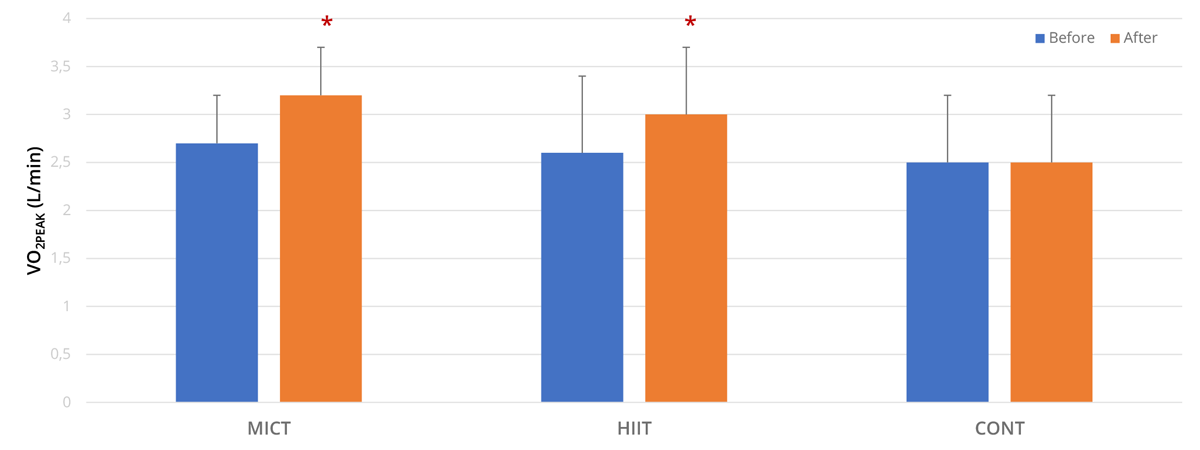HIIT à faible dose : Impact cardiométabolique

Il est démontré qu’une activité physique régulière apporte de nombreux bénéfices pour la prévention et le traitement de nombreuses maladies chroniques. Malheureusement, parmi les facteurs de risque modifiables pour l’espérance de vie, la prévalence de l’inactivité physique est la plus forte. Le “manque de temps” est l’une des principales raisons citées par les personnes interrogées pour expliquer leur sédentarité. Les recommandations officielles (OMS) préconisent de faire au moins 150 minutes hebdomadaires à intensité modérée (3-6 METs) ou 75 minutes hebdomadaires à intensité élevée (> 6 METs), par tranches de 10 minutes minimum, en plus de deux séances minimums de renforcement musculaire.
Ainsi, comme nous en avions discuté dans un article précédent, le HIIT est devenu une alternative intéressante puisque grâce à sa nature intermittente, il permet des intensités plus élevées et un temps d’entraînement plus court que l’endurance cardiovasculaire classique (ie, courir pendant 30 minutes et plus à allure constante et modérée). Et malgré le volume d’entraînement différent, il permet des bénéfices similaires à ceux observés avec le “cardio” classique. Toutefois, avec l’échauffement, certains protocoles de HIIT nécessitent tout de même d’allouer une demi-heure à sa séance. Et certains scientifiques se sont demandé si le HIIT était réellement si efficient en termes de temps. Mais qu’en serait-il si la séance de HIIT était encore plus courte ? L’impact physiologique serait-il diminué ? Et comparé à du “cardio” classique ?
L’étude réalisée
Pour répondre à ces questions, des chercheurs de l’équipe du Professeur Gibala de l’université McMaster au Canada ont comparé deux protocoles d’entraînement cardiovasculaire avec des volumes et des intensités différents et leur impact sur plusieurs paramètres métaboliques. Pour cela, ils ont réuni 25 hommes sédentaires (< 600 METs-minute par semaine) et les ont réparti en 3 groupes : HIIT (n = 9), MICT (n = 10) et Contrôle (n = 6).
Durant 12 semaines, les deux groupes d’entraînement ont participé à 3 séances par semaine (à l’exception de la 1ère et de la 2ème semaine où seules 1 et 2 séances étaient pratiquées, respectivement). Lors de la 7ème semaine, deux séances ont été remplacées par des évaluations en laboratoire. Le groupe Contrôle ne venait au laboratoire que pour les évaluations. Le programme d’entraînement se déroulait sur cyclo-ergomètre et était le suivant :
- HIIT : 3 x 20s à fond (résistance : 0.05 kg/kg de masse corporelle) avec 2 minutes de repos
- MICT : 45 min à 70% FCMAX
Pour chaque séance, un échauffement de 2 min et un retour au calme de 3 min à 50 Watts étaient inclus. La durée totale de chaque séance était donc de 10 minute pour le HIIT et de 50 minutes pour le MICT.
Avant et après les 12 semaines du protocole, les chercheurs ont évalué la masse grasse via plethysmographie, la condition cardiorespiratoire via le VO2PIC, la tolérance au glucose avec un test intraveineux à jeun réparti sur 50 minutes (IVGTT) pour déterminer l’index de sensibilité à l’insuline (CSI), l’aire sous la courbe de glucose pendant les 50 minutes et la résistance à l’insuline (HOMA-IR). Ils ont également procédé à une biopsie musculaire pour mesurer l’activité enzymatique de la citrate synthase (CS) (enzyme impliquée dans le cycle de Krebs), et de la 3-Hydroxyacyl-CoA déshydrogénase (β-HAD) (enzyme impliquée dans la β-oxydation) et pour mesurer le contenu en diverses protéines dont GLUT4, une protéine transporteur de glucose.
Résultats & Analyses
Les principaux résultats de cette étude montrent que, chez des hommes sédentaires, même à petite dose, le HIIT permet des améliorations cardiométaboliques similaires à celles observées avec le MICT. Les deux groupes ont amélioré significativement leur pourcentage de masse grasse, leur VO2PIC (+ 19%) (Fig. 1), leur sensibilité à l’insuline, le contenu enzymatique et le contenu en GLUT4. Aucune amélioration n’a été observé pour le groupe Contrôle.

En comparaison au “snack training” dont nous discutions dans un article précédent, l’amélioration du VO2PIC correspond ici à 6 ml/kg/min, soit ~1.7 METs. Cette amélioration est cliniquement significative puisque comme le montre certaines études, c’est comparable à une diminution de 7 cm de tour de taille, à une diminution de la tension artérielle de 5 mmHg ou une réduction de 1 mmol/L de la glycémie à jeun, en termes de réduction du risque de mortalité de toute cause et de maladies cardiovasculaires.
Alors que le volume des deux protocoles expérimentaux était totalement différent, 1 minute d’effort maximal sur 10 minutes pour le groupe HIIT vs. 50 minutes continues à intensité modérée (~60 vs. ~310 kJ par séance), cette étude démontre l’efficacité d’efforts brefs et intenses sur l’amélioration des paramètres cardiométaboliques. De plus, l’activité maximale de la citrate synthase est un marqueur fortement associé au contenu mitochondrial dans le muscle squelettique et les résultats de cette étude suggèrent que les améliorations mitochondriales sont fortement liées à l’intensité de l’effort plutôt qu’au volume.
Applications pratiques
3 x 10 minutes par semaine, c’est tout ce qu’il faudrait pour améliorer significativement chez des sédentaires des marqueurs de l’état de santé cardiorespiratoire et métabolique, au moins autant qu’en pratiquant 150 minutes (l’équivalent des recommandations officielles). Néanmoins, les 3 minutes d’effort réparties dans ces 30 minutes doivent être passées à intensité maximale. Ce qui ne convient pas forcément à tout le monde du point de vue des préférences personnelles. Certaines personnes n’apprécieront pas effectuer un effort long, et d’autres n’apprécieront pas devoir s’exercer à intensité maximale.
Le temps à accorder à une activité physique, et qui peut paraître être pour certains comme LA barrière principale d’accès, est finalement minime et il suffira d’une bonne volonté pour trouver le temps à lui accorder.
Références
Gillen JB, Martin BJ, MacInnis MJ, Skelly LE, Tarnopolsky MA and Gibala MJ. Twelve weeks of sprint interval training improves indices of cardiometabolic health similar to traditional endurance training despite a five-fold lower exercise volume and time commitment. PLOS ONE 11(4): e0154075, 2016.